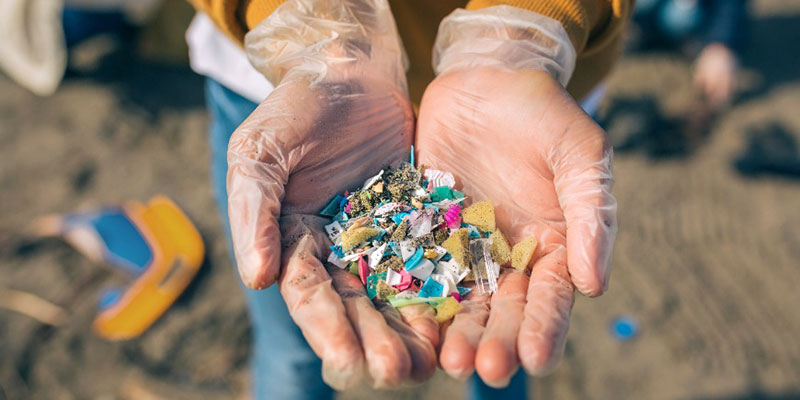Whether they’re large enough to scoop up or just a micron across, microplastics can be found virtually everywhere on our planet.
The tiny plastic particles are ubiquitous in the environment and our bodies, so what can be done to lessen risks?
They collect at the bottom of the sea in the Marianas trench. They’re carried across the sky by the jet stream, coming to rest near the summit of Mt. Everest. They fall in raindrops on remote wilderness areas. They’re detected in tap water, and they’re in bottled water, too. They already have been found in our own lung tissue, GI tracts, bloodstreams, and breast milk.
They’re microplastics, the small shards, particles, and fibers that result from the breakdown of plastic items, and they’re virtually everywhere. Most scientists consider their size range to be from 5 mm down to 1 micron. The smallest of them are the most concerning as they may be able to pass right through human protective membranes. Research has shown that the exposure of infants is 15 times that of adults. But do microplastics really pose a health risk, and, if so, what can we do to avoid them?
Microplastics ‘a Ticking Timebomb’
Some research suggests we may consume 5 grams of microplastics weekly, or about a credit card’s worth. Not enough is known about the extent to which it might pose a health risk.
Animal studies and experiments on lab-grown cells suggest that microplastics could damage cells and cause inflammation and oxidative stress, and researchers warn of the possibility of cancer and mutagenic and teratogenic abnormalities. Yet many studies have used high concentrations of microplastics or commercial-grade plastics, so the science on typical, real-world exposure levels remains sparse.
Many researchers have, nonetheless, speculated that the potential health risks may be high, with some experts calling microplastics a ticking timebomb.
Response to Microplastics Pollution
The World Health Organization has recognized an increasing awareness of microplastics among the public and a clear consensus that microplastic pollution in the environment should be mitigated.
Toward that end, many bodies have started microplastics initiatives. For example, the state of California recently mandated microplastics testing for drinking water in the first governmental mandate of its kind.
In Europe, the Netherlands initiated 15 microplastics projects in 2019 and provided more funding for a microplastics research consortium in 2021, and the European Union has committed more than $32 million to five micro- and nanoplastics studies between 2021 and 2025.
Mitigating Microplastics Pollution
A variety of water treatment processes are somewhat effective but are unable to thoroughly remove microplastics. Considering the health implications, it seems inevitable that an efficient, simple, and low-cost microplastic removal technology will eventually be developed, but combinations of existing technologies may be suitable.
Current technologies have a significant advantage over novel microplastics removal technologies because operators are familiar with them, operations are less challenging, and costs are lower. Until the ideal technology rolls out, there are familiar options that can be combined to address microplastics contamination.
Microplastics removal is a challenging new frontier of water and wastewater treatment. Fluence offers reverse osmosis solutions for microplastics removal, and our experts can tailor systems comprised of robust, existing technologies to each unique source water. Contact Fluence to learn how we can help.

